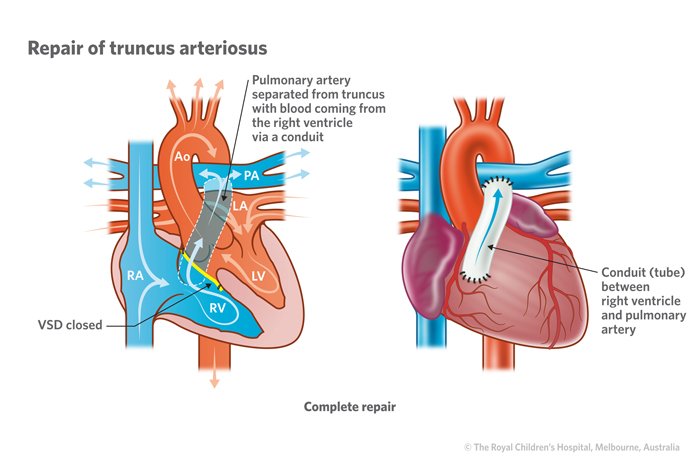What Are the Benefits and Risks of Senning’s-Truncus Repair for Infants?

Truncus arteriosus is a rare condition where a baby’s heart forms improperly, resulting in a single large artery instead of two. Approximately 1 in 10,000 babies are born with severe heart defects like truncus arteriosus each year. This condition requires immediate surgical intervention to correct the heart’s structure and function.
Senning’s-Truncus Repair is a crucial surgery to improve the heart’s ability to pump blood effectively. Understanding the benefits and risks associated with this surgery is pivotal for families and medical professionals navigating the complexities of congenital heart conditions in infants.
What Is Seining’s-Truncus Repair?
Senning’s-Truncus Repair is a surgical procedure for babies born with a heart problem called a truncus arteriosus. This surgery aims to fix the defect by rearranging the heart’s blood vessels, helping the heart work better. It involves redirecting blood flow in the heart to improve oxygen supply to the body. By doing this, the surgery helps the heart function more effectively and allows the baby to grow healthier. It’s a complex but crucial surgery that helps babies born with specific heart issues lead better lives.
Dr. Dinesh believes Seining’s Truncus Repair is amazing. He says, “It fixes complex heart issues in babies with a success rate of 95%. Instead of many surgeries, it’s just one, giving hope. After surgery, 90% of kids are healthier.”
What Is Truncus Arteriosus?
Truncus arteriosus is a congenital heart defect (a heart condition that’s present at birth). A baby with truncus arteriosus has one large artery (instead of the usual two arteries) for blood to flow in and out of the heart. These babies also have a single truncal valve instead of two valves to control this blood flow.
“Truncus arteriosus is a life-threatening condition. It requires surgery shortly after birth. Seining’ s-Truncus Repair addresses Truncus Arteriosus. This surgery boasts a success rate, significantly improving the lives of 9 out of 10 children. This procedure offers a promising solution, ensuring better heart health and brighter futures for infants with this condition,” emphasizes Dr. Dinesh.
How Does Truncus Arteriosus Affect Blood Flow?
The heart and the arteries are part of the body’s circulatory system. A healthy heart should have a pulmonary artery (which sends blue blood to the lungs) and an aorta (which sends red blood to the body). A pulmonary valve and an aortic valve are two of the four valves that control blood flow through the heart.
Typically, blood flows from the right side of the heart through the pulmonary artery to the lungs to get oxygen. This oxygenated blood then flows to the left side of the heart and through the aorta to the rest of the body. Because a baby with truncus arteriosus only has one artery leading out of the heart, blood with and without oxygen mixes.
Babies with truncus arteriosus also have ventricular septal defects (VSD). A VSD is a hole in the heart wall (septum) that separates the heart’s lower ventricles or chambers.
These two congenital heart defects allow too much blood to go into the lungs while insufficient blood reaches the rest of the body. This forces the heart and lungs to work harder.
What Other Heart Conditions Occur With Truncus Arteriosus?
Other heart conditions associated with truncus arteriosus include:
- Atrial septal defect or ASD (hole in the heart wall separating the heart’s two upper chambers or atria)
- Interrupted aortic arch (incomplete aorta)
- Patent ductus arteriosus or PDA (abnormal connection between the aorta and pulmonary artery)
What Causes Truncus Arteriosus?
In the uterus, all fetuses start with one large blood vessel (the truncus) that branches from the heart. The truncus divides into the pulmonary artery and aorta as the fetus develops. When this split doesn’t happen, truncus arteriosus occurs. Not having the separation also leads to the VSD.
Experts are still trying to determine why some fetuses develop this type of congenital heart defect. Specific gene changes may play a role. About 1 in 3 children with truncus arteriosus also have a chromosomal disorder called DiGeorge syndrome. In addition to heart defects, this condition causes immune system problems and developmental delays.
What Are The Benefits Of Seining ‘s-Truncus Repair For Infants?
Senning’s-Truncus Repair offers essential benefits for infants with certain heart defects. Here are the advantages:
- Improved Heart Function: The surgery enhances the heart’s work, allowing better blood flow and oxygen delivery throughout the body.
- Enhanced Quality of Life: Successful surgery positively impacts an infant’s health, growth, and development, leading to a better overall quality of life.
- Long-Term Positive Outcomes: Timely repair can increase the chances of a longer and healthier life for the baby by reducing potential complications as they grow.
A happy patient of Dr. Dinesh Mittal says, “My baby was born with a tough heart issue called truncus arteriosus. I was worried, but we found Dr. Dinesh Mittal, and he’s amazing! He did this surgery called Senning’s-Truncus Repair, and now my baby’s heart is so much better. Dr. Dinesh explained everything well, and we’re thankful for his expertise. Our little one is doing great now, thanks to Dr. Dinesh!”
What Are The Risks And Challenges?
Seining’s-Truncus Repair, while beneficial, carries certain risks and challenges that families should be aware of:
- Surgical Risks: Like any surgery, there are potential risks such as bleeding, infection, or adverse reactions to anesthesia.
- Postoperative Challenges: After the surgery, infants might face difficulties like irregular heartbeats, fluid accumulation, or breathing problems during recovery.
- Long-Term Considerations: There could be risks of scarring, the need for additional surgeries in the future, or other heart-related issues as the child grows up.
These challenges are essential to understand as they can affect an infant’s recovery and future health. While medical teams do their best to minimize these risks, families should stay informed and prepared for possible complications post-surgery. Regular check-ups and expert guidance are essential to address any concerns and ensure the best possible outcome for the child.
What Factors Influence The Success Rates?
Several factors play a crucial role in determining the success rates of Senning’s-Truncus Repair for infants:
- Timing of Surgery: The timing of the surgery significantly impacts its success. Early intervention can yield better outcomes.
- Severity of the Condition: The complexity and severity of the infant’s heart defect influence the success of the surgery. More complex conditions may pose more significant challenges.
- Overall Health: The general health and well-being of the infant play a vital role. Better health often contributes to a smoother recovery process.
- Individual Variations: Each child is unique, and variations in anatomy or response to treatment can affect the surgery’s success.
Understanding these factors is crucial for families and healthcare professionals. They help assess the potential outcomes and prepare for the surgery and postoperative care. Expert evaluation and personalized treatment plans tailored to the infant’s specific condition can maximize the chances of a successful outcome.
What Is The Estimated Cost Of Senning ‘s-Truncus Repair In India?
The cost range for Truncus Arteriosus Repair in India typically spans between Rs. 4,40,000 and Rs. 6,00,000 (US $8,000). However, the expense fluctuates based on several factors, such as the child’s medical background, the severity of the condition, the surgeon’s expertise, hospital facilities, and the location within India where the surgery is conducted.
Conclusion
Senning’s-Truncus Repair is a critical surgery for infants born with truncus arteriosus, a rare heart defect. While it offers improved heart function and quality of life, it also presents surgical risks and challenges. Understanding these benefits and risks, alongside factors influencing success rates, is vital for families and medical teams. By staying informed and seeking expert guidance, families can navigate the complexities of this condition and ensure the best possible care for their child’s heart health.
FAQs:
-
Can truncus arteriosus be detected before birth?
Prenatal screenings like ultrasound can sometimes detect heart defects like truncus arteriosus before birth.
-
Is truncus arteriosus a hereditary condition?
Most cases of truncus arteriosus occur sporadically, without a clear inheritance pattern, but genetic factors may sometimes contribute.
-
Are all cases of truncus arteriosus severe?
Truncus arteriosus can range from mild to severe, but most cases require surgery shortly after birth to prevent complications.
-
Can babies with truncus arteriosus breastfeed normally?
Some babies might face challenges while feeding, but with guidance, many can breastfeed or feed through other methods effectively.
-
What follow-up care is needed after Senning’s Truncus Repair?
Regular check-ups with pediatric cardiologists are necessary to monitor the baby’s heart health and growth after the surgery.
Read More : What Makes the Arterial Switch Procedure Vital for Correcting TGA in Infants?
